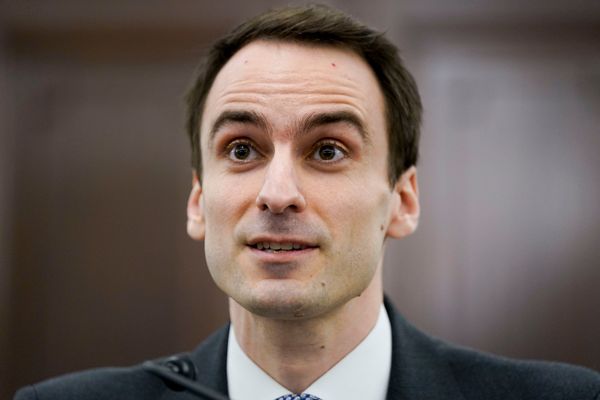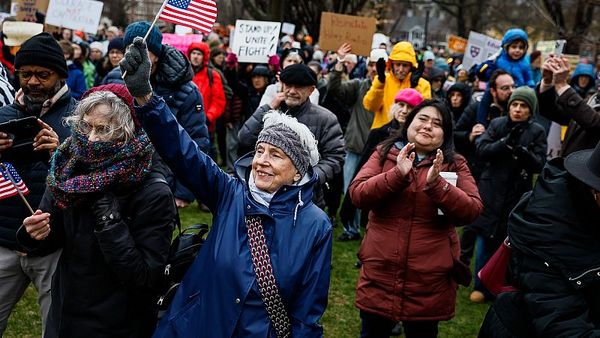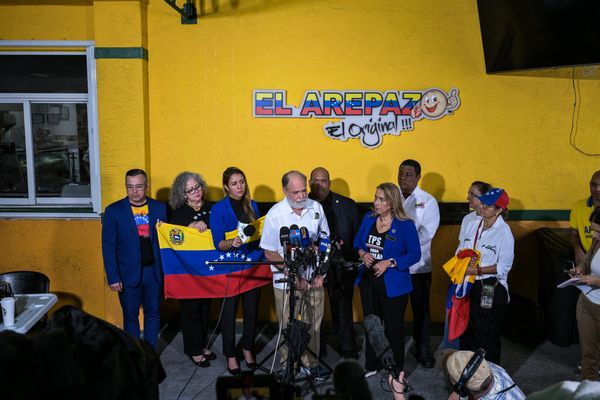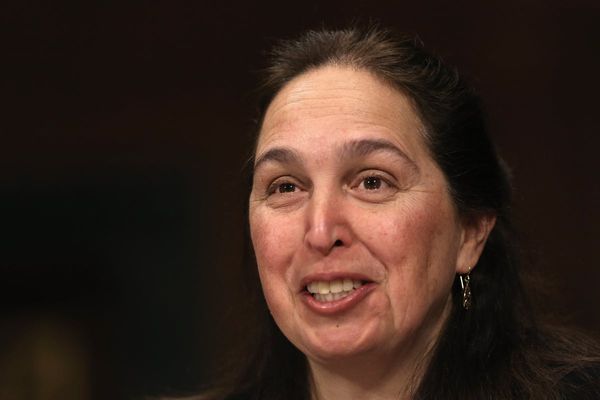
Kerry Stokes’ West Australian has not been shy about its support of mining and resources industries.
Last year an opinion piece by the Woodside chief executive, Meg O’Neill, spruiking the fossil fuel company’s interests was stretched into a front-page splash, a separate news story and an editorial without the tabloid troubling itself to include an alternative view on what she had to say.
It was a similar story this week as the newspaper continued its full-throated attack on the Albanese government over its attempts to pass legislation to create a national EPA, to be known as Environment Protection Australia.
On Thursday in not one but two front pages it attacked the federal government over the possibility that it might do a deal with the Greens and other crossbenchers that included a reference to “climate considerations” being part of deliberations when major developments are up for approval. It chose to combine its coverage of the negotiations over environmental law with the unrelated revelation that the Australian Workers’ Union wants workers to be given a $10,000 “retention bonus” each year for working in the Pilbara.
The first front page, on an advertising wrap around the paper, said there was an “Enemy at the Gate” and accused Labor of opening up “two battlefronts threatening the resources sector”. The second, inside the wrap, declared “Labor’s War on the West”.
The coverage did not mention the rationale for the environment law changes – the poor and deteriorating health of Australia’s wildlife. It also didn’t mention Stokes’ resources sector interests.
Sneesby exits Nine
It’s been a torrid few months at Nine Entertainment, with the news and current affairs director Darren Wick abruptly quitting the company in March, the June resignation of the chair Peter Costello after denied assaulting a journalist, the loss of 200 jobs, then industrial action that took place during the Olympics – to which it had exclusive broadcast rights. Nine’s shares are down about 40% for the year, compared with a gain of about 6% for the overall market.
On Thursday its chief executive, Mike Sneesby, stood down, explaining that he had faced the most challenging year of his career and would consider new opportunities in 2025. The board, now chaired by Catherine West, declared that after the end of the Olympics, it was the “right time” for the company to transition to new leadership.
To their credit the Australian Financial Review and the Sydney Morning Herald have extensively covered the leadership upheaval at their own company.
The AFR – now under the editor-in-chief, James Chessell, who left the role of Nine’s managing director of publishing in December – conceded that Sneesby’s three-and-a-half-year tenure “was marred by cultural problems and rising costs”.
The SMH pointed out the job cuts under Sneesby – including the fact that 90 came from its publishing division. It also mentioned Costello “allegedly pushed over a News Corp journalist who was asking questions about Sneesby and the turmoil”, while Wick had left amid claims of “alleged sexual harassment”, which he denied.
The market valuation of Nine on Wednesday was $1.97bn, of which about $1bn is accounted for by its property brand, Domain.
Out of the frame
The veteran art critic John McDonald has been let go from the Sydney Morning Herald – and fired some parting shots on his way out.
McDonald, who has been writing for the paper for more than 40 years, in a furious missive on his personal newsletter on Thursday announced that the Herald had “decided to dispense with my services” – news he had received via a “brief, curt note from editor Bevan Shields”.
“Bevan Shields’s personal touch was to say that I had been ‘disrespectful and unprofessional’,” he wrote.
McDonald wrote that he wasn’t wholly surprised by the decision, given he had “felt out-of-step with the direction the paper has been taking over the past 2-3 years”. He accused the Herald of “mutilating and censoring my columns without informing or consulting me”, and of having a “supine approach” to arts coverage, refusing to pick up investigations he believed were in the public interest, and instead preferring to publish articles that were “supportive” of art institutions.
Shields and the Sydney Morning Herald declined to comment.
All right on the night
It felt as though half of Australia watched the Kamala Harris v Donald Trump debate on Wednesday local time – along with an estimated 67 million other viewers.
One of those was Greg Sheridan of the Australian, who delivered swift analysis after the showdown.
“That was a pretty good debate. Trump came out by a short half head,” he told readers, under a live blog heading on Wednesday pronouncing the debate to have been “decent”.
This was news to readers, some of whom took to the comments to question whether Sheridan had been watching the same 90 minutes, live from the same Philadelphia.
Even Fox News’ Brit Hume called it: “Make no mistake about it: Trump had a bad night.”
By the next day, Sheridan had reframed his position. On reflection his slim victory for Trump appeared to have been downgraded to a tie.
“Donald Trump and Kamala Harris fought out a low-quality, functional draw,” his column on Thursday declared.
The Australian’s readers found more flaws in that analysis, with many of the hundreds of comments on the piece expressing yet more confusion. Was it a win? A draw? Or a loss?
Something that was hard to take aim at, however, was Sheridan’s comment about the debate’s aftermath: “There are two debates. One happened on TV. Now comes the debate about the debate.”
Maga cheer squad
Sky News Australia has a healthy fanbase over in the US, where Trump’s Maga supporters have given a resounding thumbs up to the network’s coverage of the debate by its hosts Paul Murray and Rita Panahi.
The duo was praised as giving the “most honest review” of the debate “you will ever see” by an X user called Ultra Maga Party.
That review included their criticism of the moderators, who they saw as a biased “disgrace”, and applause for Trump’s tough stance against illegal immigrants – as well as his references to household pets to get the world talking about those immigrants.
“If we spend the next week talking about cats, guess what?” Murray said. “That’s actually when we’re talking about illegal immigration.”
Own goal
It’s been international week in the world of football, with the Socceroos taking on Bahrain and Indonesia in World Cup 2026 qualifiers.
Last week Australia’s men lost 1-0 to Bahrain in a “horror” defeat, then on Tuesday, they drew with world No 133 Indonesia in a goalless stalemate that dealt a hefty blow to their hopes of reaching the tournament in North America.
Not that much of Australia could get behind the team. While the Bahrain game was shown on free-to-air Channel Ten, the Indonesia match was shown behind a paywall via subscriber-accessed Paramount+. Both Network Ten and Paramount+ are owned by Paramount.
As per a deal announced at the end of August – which “brings unprecedented exposure to our national teams and provides fans with unparalleled access to the Matildas and Socceroos”, Football Australia chief executive, James Johnson, said at the time – Ten has the rights to show “at least” half of the 100 games included in the deal on free-to-air television. The rest remain behind a paywall until the contract expires in 2028.
The irony of their own advert saying "Don't miss a minute" as we miss game coverage is probably lost on Paramount+#Socceroos #BestLeagueInTheWorld
— Ghost of a Poster (@InTheMixer_FM) September 10, 2024
Those who tuned into Ten at 10pm on Tuesday expecting to see Australia v Indonesia were instead given an episode of a long-running US police drama.
Final score: Socceroos fans 0-1 NCIS fans.
Media in the firing line
Sky News appears to be removing branding from its microphones when covering pro-Palestinian protests – as it did this week in Melbourne, where protesters took to the streets outside the Land Force exhibition in Melbourne Convention Centre. Some have speculated that the pro-Israeli network may be concerned its reporters might become a target at the rallies.
They might be right to be cautious, given that journalists have been caught up in the violent protests. On Wednesday the Daily Mail journalist Wayne Flower reported that he had been teargassed and hit in the stomach by a police rubber bullet.
Writing for MailOnline, he said that he had reported from violent protests before but that Wednesday’s demonstration seemed “more electric” and “more dangerous”.
The reporter described the non-lethal munition as “piercing” and wrote that while the shot hurt, “this one hit me in the guts, which despite backing off the Carlton Draught recently, remains well padded”.
– additional reporting by Adam Morton and Kate Lyons







